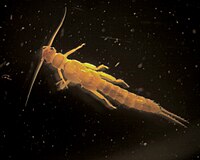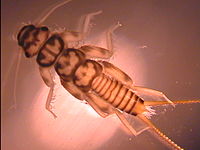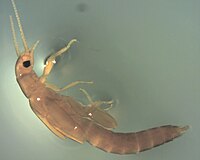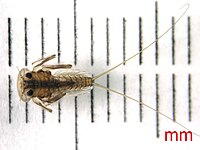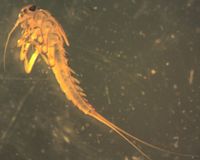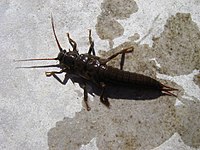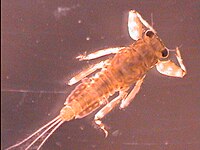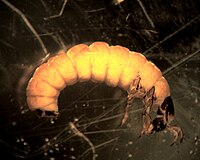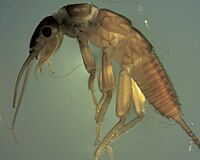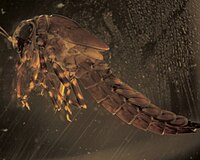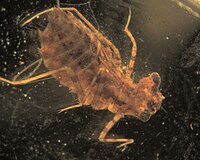Vermont EPSCoR's Streams Project; A Teacher Collaboration on WikiEducator
Openly shared content, practices, and developing resources from Vermont EPSCoR's Streams Project. Join this collaboration and make a difference!
 Roaring Branch Wallomsac Brook |
|---|
|
| Stream code: | HRD_RBWalBrk_939 |
| Basin: | Hudson River |
| State or Province: | Vermont |
| Country: | USA |
| Latitude: | 42.88271667 |
| Longitude: | -73.15831667 |
| School: | Mount Anthony Union High School |
The following are the most common invertebrates collected from this stream site.
Chironomidae
- Order
- Diptera
- Family
- Chironomidae
- Common name
- Nonbiting midge
- Tied fly
- Griffith's Gnat
Midge larvae tend to be the most common macroinvertebrate at our sites. As with other Diptera, there are no true jointed legs. Chironomidae do have a pair of prolegs at each end and preserved individuals tend to curl into a 'C'. Identification past family requires slide-mounted heads. We have seen philopotamid caddisflies misidentified with the chironomids and we suspect that that happens when samples are being sorted from trays. Under a microscope, six prominent legs can be seen on members of the caddisfly family Philopotamidae.
More information on Philopotamidae.
Chloroperlidae
- Order
- Plecoptera
- Family
- Chloroperlidae
- Common name
- The Yellow Sally
- Tied fly
- Yellow Sally
Stoneflies from the family Chloroperlidae have cylindrical banded abdomens. When observing their mouthparts, the glossae and paraglossae form a three-pronged (open) notch, and their hind wing pads are parallel (not divergent). Cerci have a vertical fringe of hairs pointing away from the abdomen. Setae on the pronotum are found primarily at the corners.
Perlidae
- Order
- Plecoptera
- Family
- Perlidae
- Common name
- The Golden Stonefly Creeper
- Tied fly
- Connecticut Curler
This stonefly is characterized by the three pairs of filamentous gills located on the sides of all three thoracic segments. It is distinguished from the family Pteronarcyidae by the absence of gills on the abdominal segments. Often, the thoracic terga are brightly patterned as pictured, though this is not always the case. Another important feature is that the paraglossae and glossae extend different lengths.
Images of filamentous gills and the family Pteronarcyidae.
Genera commonly encountered in this family include Acroneuria, Agnetina, and Paragnetina. Less commonly, we have found Perlesta.
Very rarely encountered genera include Neoperla and Hansonoperla. If you believe you have found either of these, please send a specimen our way!
Leuctridae
- Order
- Plecoptera
- Family
- Leuctridae
- Common name
- rolled-winged stoneflies or needle fly
- Tied fly
- Halford's Willow Fly
This family of stonefly is fairly slender by stonefly standards. The divergent wing pads are a helpful characteristic. Leuctridae are similar in overall shape to the Capniidae; however, Leuctridae often do not have pleural folds. If they are present, they only extend from abdominal segments 1-7. The genus
Leuctra are recognized by abdominal terga with posterior fringes of short hairs and last few segments with longer hairs.
Images of the divergent wing pads, Capniidae, abdominal terga and a ventral view can be seen here.
Heptageniidae
- Order
- Ephemeroptera
- Family
- Heptageniidae
- Common name
- flatheaded mayfly
- Tied fly
- Light Cahill, Wingless Pale Evening Dun
This family of mayflies can be characterized by their distinctly flattened heads and striking resemblance of the character 'Jack Skellington' from the movie 'The Nightmare Before Christmas.' This family can either have two or three cerci (tails).
Commonly encountered genera include:
Epeorus
Heptagenia
Maccaffertium
Rhithrogena
Baetidae
- Order
- Ephemeroptera
- Family
- Baetidae
- Common name
- Small minnow mayfly
- Tied fly
- Tiny blue-winged olive
This mayfly has either two or three cerci ("tails") and a unique head shape. Its gills are oval shaped and insert dorsally. Commonly encountered genera include
Acerpenna,
Baetis and
Pseudocloeon.
More information on the genera:
Acerpenna
Baetis
Pseudocloeon
Pteronarcys
- Order
- Plecoptera
- Family
- Pteronarcyidae
- Genus
- Pteronarcys
- Common name
- The Giant Stonefly
- Tied fly
- Kaufmann's Black Stone
Pteronarcyidae have branching gills from the bases of their legs as does
Perlidae. What distinguishes Pteronarcyidae from Perlidae is the presence of gills on the first two abdominal segments. There are only two genera in this family, but the other,
Pteronarcella, is only found in the west/southwest.
Click to see an example of Perlidae or the gills on the first two abdominal segments.
Ephemerellidae
- Order
- Ephemeroptera
- Family
- Ephemerellidae
- Common name
- spiny crawler mayflies
- Tied fly
- Blue-Winged Olive
The mayfly
Ephemerellidae is distinguished by the absence of gills on the second abdominal segment; individuals either have gills on segments 3-7 or 4-7. Some may have operculate (plate-like) gills on the fourth segment, though in many the gills are of identical size. The most commonly found genera include
Drunella,
Ephemerella, and
Serratella.
More information on the genera Drunella, Ephemerella, and Serratella.
Odontoceridae
- Order
- Trichoptera
- Family
- Odontoceridae
Members of the family Odontoceridae have sclerotized pronota and mesonota, with the metanota having some sclerotization.
Most commonly found genus is Psilotreta.
Click to see the anal prolegs and the anterior corner of the pronotum.
Hydropsychidae
- Order
- Trichoptera (caddisfly)
- Family
- Hydropsychidae
- Common name
- net spinning caddisfly
- Tied fly
- Emergent Sparkle Pupa, Vermont Hare's Ear
This family of net-spinning caddisflies is very abundant at several sites. They are important filtering collectors and are quite common at urban and agricultural sites where particles of organic material can be important food resources. Genus-level identification is possible for mature specimens and we will include the genera we found at your site if possible.
When using the key, some features that are challenging to see are the forked trochantin and the paired sclerites in the folds between segments. Other, more easily seen key features include filamentous gills on the abdominal segments and the sclerotization of the dorsal surfaces of all three thoracic segments. Keep in mind that with smaller or more immature specimens, genus-level ID may not be possible.
Commonly found genera include Cheumatopsyche, Ceratopsyche, and Hydropsyche. Less commonly, we have found Arctopsyche and Potamyia.
Images of the forked trochantin and the paired sclerites.
Glossosomatidae
- Order
- Trichoptera
- Family
- Glossosomatidae
- Common name
- saddlecase caddisfly
Larvae in this family build domed cases made of small rocks, and are often wider at segment 5. The pronotum is covered in dark, sclerotized plates, but there are either
no sclerites on the mesonotum, or the mesonotum is unsclerotized with the exception of a few patches. The anal proleg is broadly joined to segment 9; the anal claw has one or more accessory hooks. The
pronotal excision is small (approximately 1/3 anterolaterally) to accommodate the coxae.
Commonly encountered genera include Glossosoma and Agapetus.
Capniidae
- Order
- Plecoptera
- Family
- Capniidae
- Common name
- winter stonefly
Capnia stoneflies have hind wing pads that are are broad as they are long. An important distinction of the Capniidae family is the membranous pleural folds that run down the posterior abdomen segments 1-9. These look like two lines running parallel down the back of the abdomen.
Capnia are distinguished by femurs and tibia of forelegs with less than 20 fine hairs and no dorsal femoral fringe hairs.
Ventral and dorsal views are seen here.
Isonychiidae
- Order
- Ephemeroptera
- Family
- Isonychiidae
This mayfly has unique long hairs on its forelegs as the main distinguishing characteristic (allowing anyone keying to move through quickly). Carefully observe the limbs because such hair can be matted down and therefore hidden in preserved wet specimens. The body of Isonychia is slim and "minnow-like" when observed dorsally. In specimens we collected, they were commonly brown and substantial in length and width as compared to the very common Baetidae. Some individuals are immature, but upon closer inspection one can see the setae on the forelegs.
Hydroptilidae
- Order
- Trichoptera
- Family
- Hydroptilidae
- Common name
- micro caddisflies
Members of this family, commonly called micro-caddisflies are typically found in soft pouch-like cases made of silk. As the common name suggests, they are tiny, but have rather bulbous abdomens. Like the Hydropsychidae, the dorsa all three thoracic segments are sclerotized. Unlike them, however, they have no filamentous gills on their abdomens.
Hydroptila is the most common genus we encounter. A close up image can be seen here and click here for more information onHydropsychidae.
Libellulidae
- Order
- Odonata
- Family
- Libellulidae
- Common name
- Skimmer
These dragonfly larvae (sub-order Anisoptera) can be distinguished from damselfly larvae (sub-order Zygoptera) by their more robust bodies and an abdomen that ends in five 'spikes' as opposed to three gills. The family Libellulidae is characterized by their spoon-shaped mouthparts.They are distinguished from the other family with this trait, Cordulegastridae, by the small rounded teeth on the edges of their palpal lobes.
Images of the spoon-shaped mouthparts, and the small, rounded teeth.


